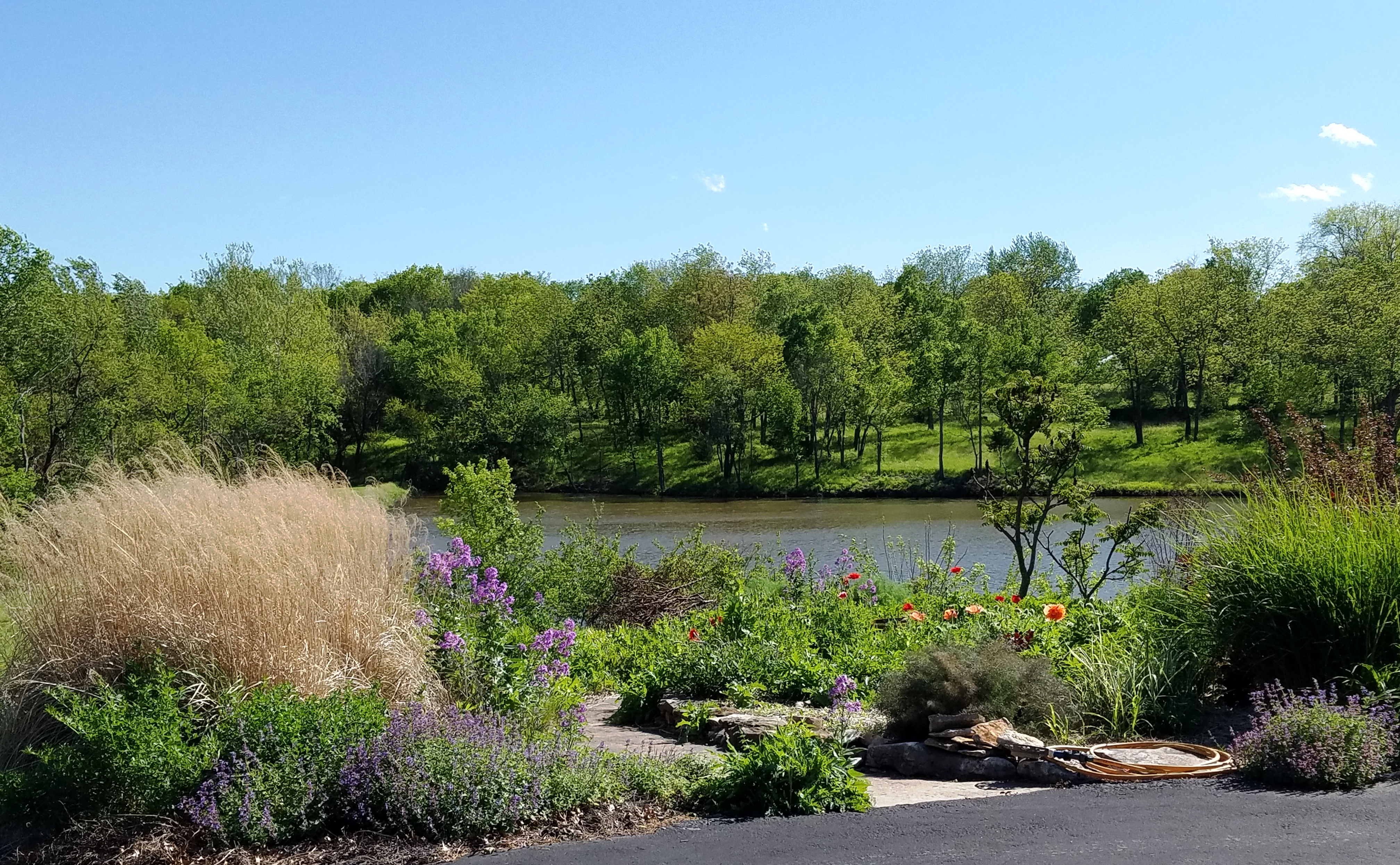Many Xerces Society members create wildlife gardens that are particularly hospitable to invertebrates. Here are three wonderful examples.
To conserve biodiversity we need to work across all landscapes. Natural areas can offer sanctuary for wildlife, while habitat on farms and roadsides can support wild creatures in human-altered environments and serve as movement corridors. Yards and gardens have an important role to play in making our landscapes more hospitable. The benefits extend well beyond insects and other invertebrates, since they are frequently fundamental components of food webs that sustain many other animals.
Studies show that towns and cities can harbor a greater diversity and abundance of invertebrates than does most farmland, even providing homes for rare and declining species such as the rusty patched bumble bee. Many Xerces Society members create wildlife gardens that are particularly hospitable to invertebrates, and among them are some wonderful examples. I recently spoke with Bert and Betty Feingold, Lenora Larson, and Dennis Krusac and Jacqueline Belwood to find out more about how these dedicated gardeners care for insects in their own backyards. From the high desert of Arizona, to rural Kansas, to suburbs in Georgia, they are united by their deep-seated love for conserving the natural world, and all of them are rewarded with the pleasure of sharing their land with myriad fascinating species.
The Feingolds are keenly observant and unceasingly curious. Both of them enjoy watching and learning from the legion of “critters” that call their two-and-a-half-acre Arizona property home. “This is a biological laboratory, which is great for anyone who wants to learn about nature,” Betty notes. She and Bert, who have been Xerces Society donors for more than two decades, strive to keep their landscape as natural as possible, managing it in ways that support healthy ecosystems typical of their desert region.
They have a wash—a dry stream bed—that runs through their property and functions as a highway for mammals such as javelinas, bobcats, and coyotes. The wash helps to channel water during infrequent rainstorms, and Bert and Betty endeavor to keep it clear of debris. When a tree falls, they will move it out of the wash, depositing it elsewhere on their land. Similarly, when pruning their trees, they will leave limbs in strategic locations so that animals large and small can utilize them for shelter and sources of food. They also provide houses for bees and butterflies, and keep a woodpile as shelter for insects and other creatures. That woodpile has attracted a throng of invertebrate visitors; these include a number of tarantulas, among them one that the couple has named Tommy.
The Feingolds also maintain a series of interconnected ponds—an unusual feature in the desert—which are filtered naturally with sand and gravel rather than a manufactured filtration system. A profusion of elegant dragonfly and damselfly species and hundreds of bees are attracted to the water and the various aquatic plants, including lilies, watercress, and iris. Bert and Betty enjoy viewing the various visitors to their ponds through their kitchen’s bay window.

In rural Kansas, Lenora Larson’s property also has a prominent water feature—a reservoir built by the Works Progress Administration in the 1930s—which is surrounded by verdant wetlands, prairie, savanna, and woodlots. A master gardener, speaker, writer, and invertebrate enthusiast who has been a Xerces Society donor for twenty years, Lenora carefully manages her land to maintain the wide variety of habitats it supports. “People assume that if it’s natural, it will just do what it does, but it requires constant intervention to maintain natural habitat,” Lenora explains.
One way in which Lenora intervenes is by conducting seasonal burns of the prairie, a practice rooted in the cycles that once characterized North America’s Great Plains. Left alone, Lenora’s prairie can become in undated with invasive species. Controlled burning, on the other hand, allows a diversity of wildflowers to grow in balanced abundance. That diversity, in turn, supports an array of wildlife, and Lenora is visited by a multitude of butterflies, birds, mammals, and reptiles.

Lenora’s approach would not be allowed in the suburb outside of Atlanta, Georgia, where Dennis Krusac and Jacqueline Belwood, Xerces Society members for nine years, live. Indeed, the two face obstacles to maintaining a diverse garden that are not altogether natural. They are often at odds with the stringent standards of the local homeowners’ association, which they have nick-named “the yard police.” “They don’t like anything that doesn’t look manicured,” Dennis says of the association, his tone suggesting a defiant shrug.
As an example, about two years ago Dennis was experimenting with alternatives to a lawn in his front yard. He would have preferred to be able to tear out the grass and add flowerbeds, but that is not an acceptable option. So instead he elected to plant a variety of small flowering plants among the grass. Although the homeowners’ association perceived these plants as “weeds,” ultimately Dennis was able to work out a compromise: keeping the diverse plants cut short.
The pushback hasn’t deterred Dennis and Jacqueline from creating a half-acre suburban oasis. They plant “anything native that blooms,” as well as some select nonnative flower varieties. They purposefully conduct minimal maintenance so as not to disturb the diverse collection of insects that feed, nest, and breed on their plants. As Dennis explains, Georgia’s climate allows them to have a garden that blooms year-round and provides nectar resources to support pollinators. The results speak for themselves: Dennis and Jacqueline are visited throughout the year by a host of creatures, from bumble bees to birds. They have also pursued a number of certifications, including the Xerces Society’s designation as pollinator habitat. They see such certification—and the accompanying signage—as a subtle teaching tool, raising awareness among neighbors and visitors that such an achievement is both possible and desirable. Lenora, whose two-acre butterfly garden is certified by a handful of other organizations as well as Xerces, shares this sentiment. “I’m a believer in certification for a number of reasons,” she says. “It supports the organization, and when you have that sign, people ask about it, and it becomes a teachable moment.” Lenora has found that certification attests to her expertise while inspiring others to achieve more pollinator-friendly standards. Indeed, she became a master gardener not just because of her passion for plants, but also because it offers added legitimacy for the many articles and talks she gives on creating habitats that support invertebrates.
Lenora adds that a significant component of her decision making is observing what does and does not attract pollinators; in some cases, for example, she has found that nonnative flowers can provide nectar for butterflies. And she is similarly pragmatic about her species choices for human reasons. Since Lenora uses her butterfly garden as a teaching tool, hosting a variety of workshops for fellow master gardeners and other community members, she recognizes that the more showy species help motivate people. After all, as she observes, “If people don’t love their garden or think it’s beautiful, they won’t do the work,” which could mean that they miss out on the opportunity to see and connect with plants and their pollinators. Indeed, Lenora considers it vitally important for people to have hands-on experiences with insects, so that they develop not just an understanding of these important creatures, but also a fondness for them.

Dennis and Jacqueline, with their knowledge of botany and pollinators, also cultivate a mix of native and nonnative species. They grow several types of milkweed for monarch butterflies, and have prioritized plants that bloom throughout the year as a way of providing nectar resources, which in some cases leads them to plant such nonnative species as zinnias. As Dennis observes, “They’re easy and colorful, and they draw lots of pollinators.”
And Dennis has an interesting story behind some of their other plants. He’ll “rescue” flowering species from construction sites and replant them in his yard. Sometimes these are natives that he recognizes—wild geraniums, for instance—and in some cases, such as when he dug up a shade-loving sunflower variety, he will end up with a nonnative plant with which he is unfamiliar, but that is a net positive for pollinators.
The Feingolds’ property also features a combination of native and nonnative species. One half of their land is essentially untouched desert habitat, featuring mesquite, ironwood, creosote bush, and other natives. The other half, around their house and ponds, is more maintained and features more nonnative species. They used to have a vegetable garden, but, as they say, “the critters won.” The vegetables, and sometimes the entire plants, were eaten. Bert and Betty took it in stride, even watching with fascination as a tomato hornworm demolished one of their plants. The hornworm “had a good time,” says Betty. “We knew that the plant was gone, so we just had fun watching him.” Now they simply maintain a small assortment of potted tomatoes and other plants on their southern porch, a favored spot for reading and for observing the various insect species that are drawn there.
Other nonnatives on the Feingolds’ land are the trees in their citrus grove, which buzz in the spring with a broad assortment of bees and other insects. These trees do require watering and fertilizing, but Bert and Betty try to keep it to a minimum. In contrast, the native plants on their property—including mesquite trees that are more than a hundred years old—do not need watering, nor much maintenance of any kind, a testament to the fact that xeriscaping is far less resource intensive and thus much more sustainable in drier climates.
Indeed, utilizing native species when possible is the most sustainable option, and brings greater benefits to native pollinators and other insects. As these three properties illustrate, a wildlife-friendly landscape doesn’t come about by chance, and some planning and maintenance will be needed no matter the size of your garden. Still, because highly manicured yards are seldom the best for insects, providing for bees, butterflies, and many other animals often requires less labor, giving you more time to relax and enjoy the visitors.
As Bert Feingold puts it: “Everything has a purpose in this life cycle, on this Earth. I pay the taxes on my property, but the animals own it.” May we all learn to work within our respective environments, rather than working against them. Not only will our lives be richer for it, but the well-being of invertebrates and our ecosystems depend upon it.
Further Reading
This piece originally appeared in the Xerces Society publication Wings. Read the full spring 2019 issue.
Learn more about the Xerces Society’s Pollinator Conservation Program.
Check out the rest of our Pollinator Week content here!




